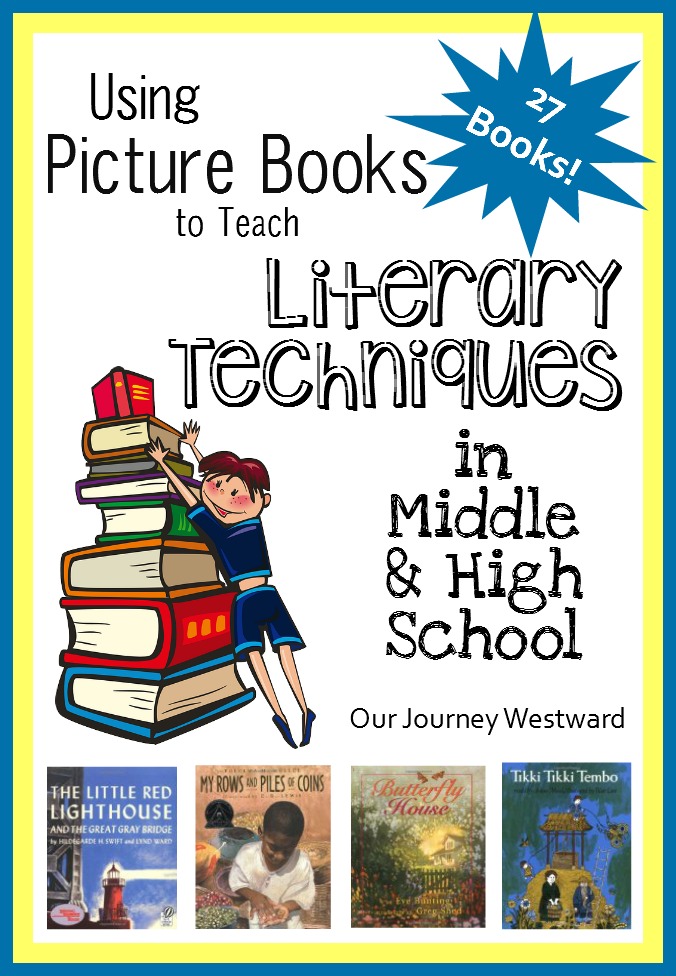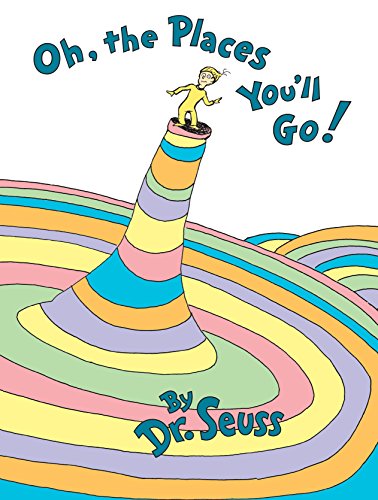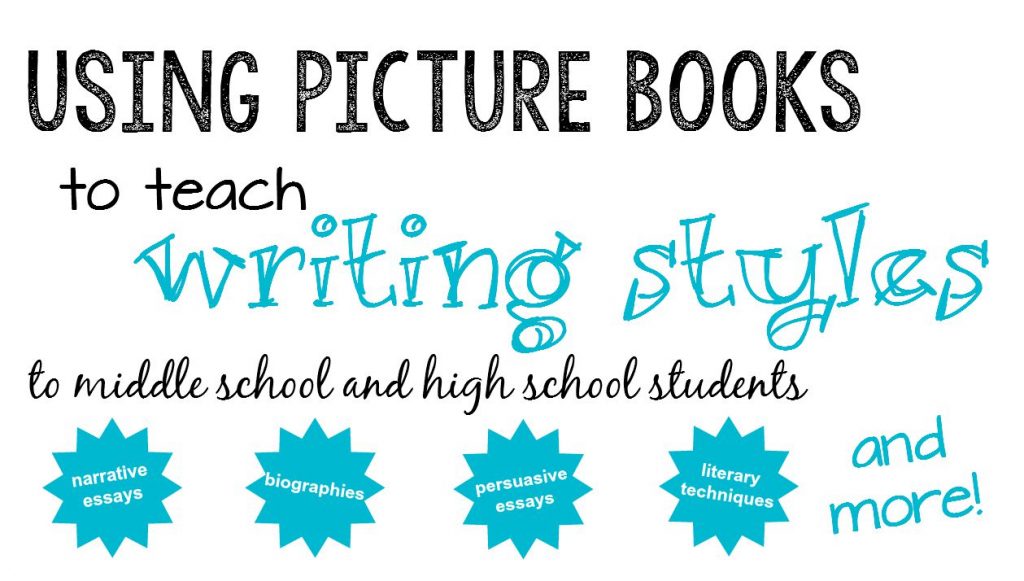Picture Books to Teach Literary Techniques
I’ve been sharing a little series of posts about how to use living literature to teach writing – specifically, narratives and persuasive pieces. In this post, I’m focusing less on a particular style of writing and more on writing with style – otherwise known as literary techniques.
No matter the age of your children, you can use these picture books to teach literary techniques. However, since I don’t begin formal writing lessons until 5th or 6th grade, I only casually mention the literary techniques to elementary students. So, yes, you read correctly…When it comes to actual writing lessons, I’m using these picture books with middle and high school kids!

Why use picture books to teach literary techniques?
While I could (and do) certainly use longer literary works and poetry to demonstrate literary techniques, picture books make for quick reads that get the lesson concept across clearly. Not to mention, {living} picture books are really good at helping young writers learn how to compose short pieces well. Most young writers I meet aren’t writing 300 page novels in the beginning. In fact, asking them to write three pages can be overwhelming. Picture books help writers see that even short stories can be written well.
What is a literary technique?
Don’t be confused. Literary techniques are not the same as literary elements. Both are important in writing! I like to think of literary elements as the building blocks of a story, while literary techniques use words artistically.
Literary elements – characters, setting, plot, theme, moral – are the basic parts included in most stories.
Literary techniques – alliteration, metaphors, onomatopoeia, personification – might or might not be included in a story. They play with words to develop interest and variety.
Together, these are known as literary devices. Both are important to purposely teach and develop. Today, I’ll only focus on literary techniques. There are many literary techniques used in writing. I’ve only included books that teach the most common techniques to get you started.
Picture Books to Teach Literary Techniques
Allegory
While it’s first on my list alphabetically, allegory is actually the most difficult technique (of those I’ve included) because it’s typically used throughout an entire story, rather than here and there like other techniques. An allegory tells one story, while the underlying meaning transfers to something else. That’s hard to understand, isn’t it?
As an example, The Squire and the Scroll tells the story of a young squire who must bravely follow the words from his scroll in order to survive and even defeat an evil dragon. The allegory of the story helps readers understand the importance of purity and following the Word of God.
Alliteration
Alliteration uses the same letter or sound several times throughout a sentence, paragraph or story. It’s used to focus the reader’s attention.
An example: Peter Piper picked a peck of pickled peppers.
Some Smug SlugOh, the Places You’ll Go!Tikki Tikki Tembo
Hyberbole
Hyperbole, otherwise known as exaggeration, is another technique that tends to be used throughout an entire story rather than in just a few places within a story. Many of us would call these stories “tall tales.” Tall tales usually have an element of humor in them, making these fun to write.
Kate and the Beanstalk (Anne Schwartz Books)The BunyansJohn Henry (Picture Puffins)
Idioms
If I’m being truthful, idioms drive me crazy! My youngest son loves them, though, so I get to read lots and lots of idioms. His favorite idiom stories are the Amelia Bedelia books. If you’ve ever read Amelia Bedelia, you’ll know that she takes idioms literally. If someone tells her to dress a turkey, she puts clothing on a turkey. Idioms, then, are phrases that shouldn’t really be taken literally like “it’s raining cats and dogs.”
Amelia Bedelia (I Can Read Book)Monkey BusinessThe Cat’s Pajamas
Imagery
Imagery is vivid and descriptive language that paints wonderful pictures in the reader’s mind as it evokes the senses. Obviously, imagery utilizes adjectives, adverbs and rich words well. An example: “The aroma of freshly brewed hot chocolate filled the room making everyone feel warm and cozy.”
Butterfly HouseWind FlyersA Story for Bear
Irony
When something is ironic, it’s the opposite of what you would have expected. In the book Caps for Sale, for instance, the peddler tries and tries to get monkeys to take his caps off of their heads. Ironically, once he gets angry and throws his cap down, the monkeys (mimicking his every move) throw the caps down. It’s not at all what the peddler expected. It was ironic that they did what he wanted when he stopped trying.
Caps for Sale: A Tale of a Peddler Some Monkeys and Their Monkey BusinessMy Rows and Piles of CoinsBig Bad Bruce
Metaphors and Similes
Both metaphors and similes compare things. Typically, similes use the words “like or as” within the phrase of comparison. For example, “I was as cold as ice.” Or, “It felt like a razor on my back.”
Metaphors make comparisons without using the words “like or as.” For example. “The store was a gold mine.” Or, “The fog was a curtain.”
In both cases, the techniques help readers to build clear mind pictures. I love how easily they can be inserted into any type of writing to create a strong impact.
Amber on the Mountain (Picture Puffins)The ButterflyOwl Moon
Onomatopoeia
Onomatopoeia is such a big word for such an easy technique. Basically, any word that sounds like its name is onomatopoeia. “Achoo” “Buzz” “Creak” “Zoom” “Pop”
These words, used sparingly, can pack a lot of emotion into a story.
Click, Clack, Moo Cows That TypeBlueberries for SalThe Tale of Peter Rabbit
Personification
Personification is one of my favorite literary techniques. Any time a non-human takes on characteristics of a human in stories, it’s called personification. So, when a tree can think or a mouse can talk or a car has feelings, that’s personification. We see examples of personification all over the place, but these three books have made me happy for years and years, so they get the honor of being highlighted.
The Little Red Lighthouse and the Great Gray Bridge: Restored EditionSylvester and the Magic PebbleMike Mulligan and His Steam Shovel 75th Anniversary (Read Along Book)
How do you use the books?
Usually, I introduce my children (or co-op students) to the literary technique first. I give them a definition and some examples, then ask them to help me come up with some examples.
Next, we’ll read the book together paying special attention to the use of the technique.
Afterwards, we’ll talk about how the author crafted his or her words and made the technique really work with the story. Again, we work together to write some examples. (These are always better than the examples before the book was read!)
Sometimes I just challenge the kids to use the technique more often. Other times, we go directly into some story writing time where they must use the technique effectively.
And, there you have it. Use a few of these books to teach your writing lessons and watch your writers grow exponentially!
Need a little more direction in how to use picture books to teach writing?
I taught a practical class that can help!
Be sure to check out the other posts in this series to get ideas for using picture books with various styles of writing and literary techniques!






























Loving this series! Thank you for making it easy for us to incorporate wonderful books into the teaching of writing. What a fun way to learn about these writing techniques! You are a blessing!
Corinne, YOU are a blessing for taking the time to share such a sweet comment!
This is SUCH a great post, cindy!
Thank you, Alicia! Picture books are my happy place.
Thanks for this series–I really am enjoying it, and taking notes for upcoming lessons. Picture books are the best!
Cindy, you just really inspire me! Every time I visit your blog, I am more inspired to teach my children with more creativity and enthusiasm. This is a great post, and my all-time favorite picture book is on this list: Sylvester and the Magic Pebble–such a moving book. It takes you to utter despair and then to elation, all within 32 pages! Cindy, I used to be a more eclectic homeschool mom, like you, but now I have two toddlers who capitalize almost all my energy, and I am not sure how to fit it in anymore. My oldest kids are very independent learners, and they take pride in that, but I want to be more involved, like when we read lots of picture books together. I guess I haven’t found that balance. At least I can do all that sort of stuff with my two youngest ones.
Alicia, I hear you about balance! That’s definitely tough and I’ve been there. I finally decided it was really OK for my big kids to work mostly independently (and is very good for them.) I’m not constantly hands-on with them in every subject. And, I KNOW you are an awesome teacher for your kids! 😉
This is my first time visiting your blog and I just have to thank you! This is awesome! My kids and I will love revisiting some of these books that we did unit studies on long ago! I have used a picture book called “Aunt Isabel Tells a Good One” with kids in upper elementary to help understand literary elements of a short story. I love these ideas for introducing literary techniques as well. Thanks so much for sharing.
Thank you, Melissa! I can wait to check out the book you mentioned!
These look like some great suggestions – I love using picture books with older kids!
Me, too!
This is fantastic! You know, I would happily buy a download that included these and more of the literary techniques illustrated through children’s books. Such a great and accessible way to demonstrate this! Also- I just want to thank you for linking to Barnes and Noble instead of Amazon. I worked there for several years before leaving to homeschool, and I loved every minute of it. My co-workers were awesome & many of them are still working there. Just appreciate anything that keeps a brick-and-mortar afloat & helps out my friends .
Jennifer, thanks so much for sharing this with me! I’ve had a few other requests for a download recently. It’s definitely on my to do someday soon list. 🙂
Thank you!
🙂
Very helpful and inspiring. You are such an angel full of blessings. Would feel lucky if more knowledge in children’s literature and writing style is provided.
I’m glad it was helpful, Minu! 🙂